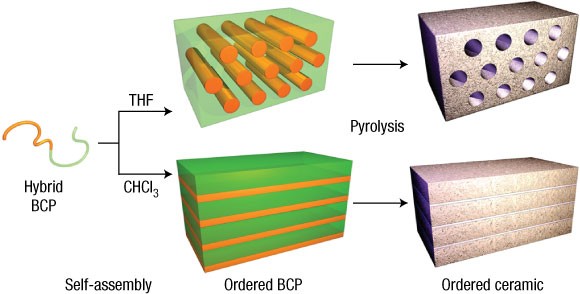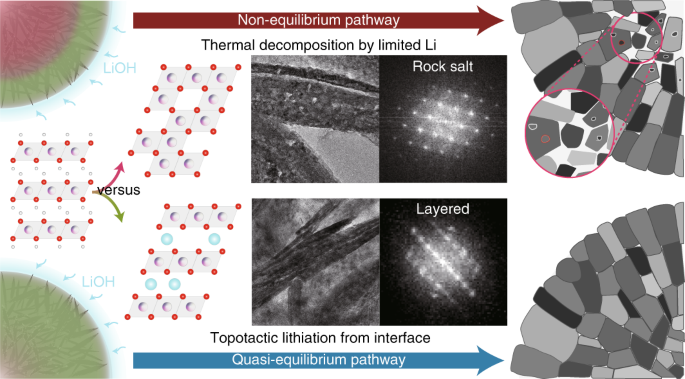
- Select a language for the TTS:
- UK English Female
- UK English Male
- US English Female
- US English Male
- Australian Female
- Australian Male
- Language selected: (auto detect) - EN
Play all audios:
ABSTRACT Self-assembly is a promising approach for achieving controlled nanoscale architectures in ceramics. The addition of ceramic-forming precursors to templating agents such as
self-assembled surfactants or organic block copolymers (BCPs) has thus far been the primary route to forming ordered nanoporous oxides1,2,3,4,5 and nanostructured non-oxide ceramics6,7,8,9.
In spite of its viability, however, this approach has several intrinsic shortcomings, including: (1) stringent requirements for amphiphilicity between template and precursor, lack of which
may lead to macro-phase separation and loss of nano-scale order; (2) morphologies that can change uncontrollably with varying amounts of added ceramic precursor. Here we report a novel
single-source ceramic precursor, based on a hybrid organic–inorganic BCP of polynorbornene–decaborane, that enables the formation of ordered ceramic nanostructures with tunable morphology
and composition. In particular, we describe the synthesis of nanostructured boron carbonitride and mesoporous boron nitride, the latter of which exhibits the highest reported surface area
for this material to date. Access through your institution Buy or subscribe This is a preview of subscription content, access via your institution ACCESS OPTIONS Access through your
institution Subscribe to this journal Receive 12 print issues and online access $259.00 per year only $21.58 per issue Learn more Buy this article * Purchase on SpringerLink * Instant access
to full article PDF Buy now Prices may be subject to local taxes which are calculated during checkout ADDITIONAL ACCESS OPTIONS: * Log in * Learn about institutional subscriptions * Read
our FAQs * Contact customer support SIMILAR CONTENT BEING VIEWED BY OTHERS RING-OPENING POLYMERIZATION-INDUCED CRYSTALLIZATION-DRIVEN SELF-ASSEMBLY OF POLY-L-LACTIDE-_BLOCK_-POLYETHYLENE
GLYCOL BLOCK COPOLYMERS (ROPI-CDSA) Article Open access 17 September 2020 VERSATILE SYNTHESIS OF UNIFORM MESOPOROUS SUPERPARTICLES FROM STABLE MONOMICELLE UNITS Article 13 November 2024
ONE-DIMENSIONALLY ORIENTED SELF-ASSEMBLY OF ORDERED MESOPOROUS NANOFIBERS FEATURING TAILORABLE MESOPHASES VIA KINETIC CONTROL Article Open access 09 December 2023 REFERENCES * Kresge, C. T.,
Leonowicz, M. E., Roth, W. J., Vartuli, J. C. & Beck, J. S. Ordered mesoporous molecular sieves synthesized by a liquid crystal template mechanism. _Nature_ 359, 710–712 (1992). Article
CAS Google Scholar * Templin, M. et al. Organically modified aluminosilicate microstructures from block copolymer phases. _Science_ 278, 1795–1798 (1997). Article CAS Google Scholar *
Pai, R. A. et al. Mesoporous silicates prepared using preorganized templates in supercritical fluids. _Science_ 303, 507–510 (2004). Article CAS Google Scholar * Chan, V. Z.-H. et al.
Ordered bicontinuous nanoporous and nanorelief ceramic films from self-assembling polymer precursors. _Science_ 286, 1716–1719 (1999). Article CAS Google Scholar * Ulrich, R., Du Chesne,
A., Templin, M. & Wiesner, U. Nano-objects with controlled shape, size and composition form block copolymer mesophases. _Adv. Mater._ 11, 141–146, (1999). Article CAS Google Scholar *
Kamperman, M., Garcia, C. B. W., Du, P., Ow, H. & Wiesner, U. Ordered mesoporous ceramics stable up to 1500 °C from diblock copolymer mesophase. _J. Am. Chem. Soc._ 126, 14708–14709
(2004). Article CAS Google Scholar * Wan, J. et al. Nanostructured non-oxide ceramics templated via block copolymer self-assembly. _Chem. Mater._ 17, 5613–5617 (2005). Article CAS
Google Scholar * Armatas, G. S. & Knatzidis, M. G. Mesostructured germanium with cubic pore symmetry. _Nature_ 441, 1122–1125 (2006). Article CAS Google Scholar * Sun, D. et al.
Hexagonal nanoporous germanium through surfactant-driven self-assembly of zintl clusters. _Nature_ 441, 1126–1130 (2006). Article CAS Google Scholar * Galloro, J. et al. Replicating the
structure of a crosslinked polyferrocenylsilane inverse opal in the form of a magnetic ceramic. _Adv. Funct. Mater._ 12, 382–388 (2002). Article CAS Google Scholar * Temple, K. et al.
Spontaneous vertical ordering and pyrolytic formation of nanoscopic ceramic patterns from poly(styrene-_b_-ferrocenylsilane). _Adv. Mater._ 15, 297–300 (2003). Article CAS Google Scholar
* Bates, F. S. & Fredrickson, G. H. Block copolymers – designer soft materials. _Physics Today_ 52, 32–38 (1999). Article CAS Google Scholar * Shen, Q. H. & Interrante, L. V.
Structural characterization of poly(silylenemethylene). _Macromolecules_ 29, 5788–5796 (1996). Article CAS Google Scholar * Seyferth, D., Strohmann, C., Dando, N. R. & Perrotta, A. J.
Poly(ureidosilazanes): preceramic polymeric precursors for silicon carbonitride and silicon nitride. Synthesis, characterization, and pyrolytic conversion to Si3N4/SiC ceramics. _Chem.
Mater._ 7, 2058–2066 (1995). Article CAS Google Scholar * Wei, X., Carroll, P. J. & Sneddon, L. G. New routes to organodecaborane polymers via ruthenium-catalyzed ring-opening
metathesis polymerization. _Organometallics_ 23, 163–165 (2004). Article CAS Google Scholar * Welna, D. T., Bender, J. D., Wei, X., Sneddon, L. G. & Allcock, H. R. Preparation of
boron-carbide/carbon nanofibers from a poly(norbornenedecaborane) single-source precursor via electrostatic spinning. _Adv. Mater._ 17, 859–862 (2005). Article CAS Google Scholar * Wei,
X., Carroll, P. J., Sneddon, L. G. Ruthenium-catalyzed ring-opening polymerization syntheses of poly(organodecaboranes): New single-source boron-carbide precursors. _Chem. Mater._ 18,
1113–1123 (2006). Article CAS Google Scholar * Choi, T.-L. & Grubbs, R. H. Controlled living ring-opening-metathesis polymerization by a fast-initiating ruthenium catalyst. _Angew.
Chem. Int. Edn._ 42, 1743–1746 (2003). Article CAS Google Scholar * Lodge, T. P., Pudil, B. & Hanley, K. J. The full phase behavior for block copolymer in solvents of varying
selectivity. _Macromolecules_ 35, 4707–4717 (2002). Article CAS Google Scholar * Funaki, Y. et al. Influence of casting solvents on microphase-separated structures of
poly(2-vinylpyridine)-block-polyisoprene. _Polymer_ 40, 7147–7156 (1999). Article CAS Google Scholar * Mirabelli, M. G. L. & Sneddon, L. G. Synthesis of boron nitride via a polymeric
vinylpentaborane precursor. _Inorg. Chem._ 27, 3271–3272 (1988). Article CAS Google Scholar * Rees, W. S. Jr & Seyferth, D. High-yield synthesis of boron carbide (B4C)/boron nitride
ceramic materials by pyrolysis of polymeric Lewis base adducts of decarborane(14). _J. Am. Ceram. Soc._ 71, C194–C196 (1988). Article CAS Google Scholar * Dibandjo, P., Chassagneux, F.,
Bois, L., Sigala, C. & Miele, P. Comparison between SBA-15 silica and CMK-3 carbon nanocasting for mesoporous boron nitride synthesis. _J. Mater. Chem._ 15, 1917–1923 (2005). Article
CAS Google Scholar * Dibandjo, P. et al. Synthesis of boron nitride with ordered mesostructure. _Adv. Mater._ 17, 571–574 (2005). Article CAS Google Scholar * Vinu, A. et al. Synthesis
of mesoporous BN and BCN exhibiting large surface areas via templating methods. _Chem. Mater._ 17, 5887–5890 (2005). Article CAS Google Scholar * Han, W. Q., Brutchey, R., Tilley, T. D.
& Zettl, A. Activated boron nitride derived from activated carbon. _Nano Lett._ 4, 173–176 (2004). Article CAS Google Scholar * Hagio, T., Nonaka, K. & Sato, T. Microstructural
development with crystallization of hexagonal boron nitride. _J. Mater. Sci. Lett._ 16, 795–798 (1997). Article CAS Google Scholar * Jacobsen, C. J. H. Boron nitride: a novel support for
ruthenium-based ammonia synthesis catalysts. _J. Catal._ 200, 1–3 (2001). Article CAS Google Scholar * Hansen, T. W. et al. Atomic-resolution in situ transmission electron microscopy of a
promoter of a heterogeneous catalyst. _Science_ 294, 1508–1510 (2001). Article CAS Google Scholar Download references ACKNOWLEDGEMENTS The authors would like to thank M. Blohm for
financial support as well as M. Latorre and D. Vissani (thermal analysis), G. Goddard (MALLS), L. Denault (SEM), P. Donahue (NMR), W. Heward (X-ray), J. Mckiever (BET) and J. Leist
(elemental analysis) for technical support. We also wish to thank S.T. Dhanasekaran at UMASS Amherst for assistance with SAXS data collection and Xiaolan Wei for valuable discussions. AUTHOR
INFORMATION Author notes * Patrick R. L. Malenfant and Julin Wan: These authors contributed equally to this work AUTHORS AND AFFILIATIONS * GE Global Research Center, 1 Research Circle,
Niskayuna, New York, 12309, USA Patrick R. L. Malenfant, Julin Wan, Seth T. Taylor & Mohan Manoharan Authors * Patrick R. L. Malenfant View author publications You can also search for
this author inPubMed Google Scholar * Julin Wan View author publications You can also search for this author inPubMed Google Scholar * Seth T. Taylor View author publications You can also
search for this author inPubMed Google Scholar * Mohan Manoharan View author publications You can also search for this author inPubMed Google Scholar CONTRIBUTIONS P.M. and J.W. conceived,
designed and performed the experiments. S.T. performed the TEM analysis. All authors discussed the results and commented on the manuscript. CORRESPONDING AUTHORS Correspondence to Patrick R.
L. Malenfant or Julin Wan. SUPPLEMENTARY INFORMATION SUPPLEMENTARY INFORMATION (PDF 492 KB) RIGHTS AND PERMISSIONS Reprints and permissions ABOUT THIS ARTICLE CITE THIS ARTICLE Malenfant,
P., Wan, J., Taylor, S. _et al._ Self-assembly of an organic–inorganic block copolymer for nano-ordered ceramics. _Nature Nanotech_ 2, 43–46 (2007). https://doi.org/10.1038/nnano.2006.168
Download citation * Received: 06 September 2006 * Accepted: 20 November 2006 * Published: 03 January 2007 * Issue Date: 01 January 2007 * DOI: https://doi.org/10.1038/nnano.2006.168 SHARE
THIS ARTICLE Anyone you share the following link with will be able to read this content: Get shareable link Sorry, a shareable link is not currently available for this article. Copy to
clipboard Provided by the Springer Nature SharedIt content-sharing initiative







